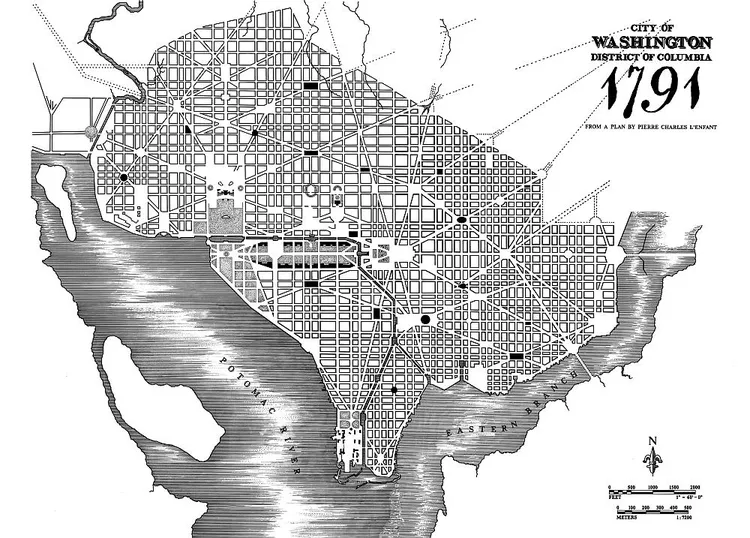Summary of the National Mall
The National Mall serves as the monumental core of Washington DC, tracing its history back to the establishment of the City of Washington as the seat of the United States government. This iconic public space evolved alongside the growth of the city and the nation. Below is a detailed overview of the history and development of the National Mall.
The L’Enfant Plan and the National Mall
In 1791, President George Washington appointed Pierre Charles L’Enfant, a French-born architect, to design the ten-mile-square territory that would become the nation’s capital, the District of Columbia. L’Enfant’s design featured a grid of streets that ran north-south and east-west, complemented by grand avenues and open spaces intended for monuments and memorials. He proposed a “grand avenue” stretching approximately one mile between the Capitol Building and an equestrian statue of George Washington, envisioned for placement south of the White House, where the Washington Monument stands today.
The McMillan Plan of 1901-1902
Fast forward to 1901, when Senator James McMillan of Michigan led a committee of distinguished architects and designers to create an updated vision for the Mall. The McMillan Plan expanded upon L’Enfant’s original layout, shaping the National Mall as it exists today. The plan proposed re-landscaping the Capitol Grounds, extending the Mall to incorporate West and East Potomac Park, and establishing sites for the Lincoln Memorial and Jefferson Memorial. Additionally, it included relocating city railways (including Union Station) and designing a municipal office complex in the area known as Federal Triangle.
The National Mall in the 20th Century
Throughout the mid-1900s, the National Mall emerged as a central hub for public celebrations and civic events. Major historical events, such as the 1963 March on Washington and the 1995 Million Man March, were staged here. The Mall also became home to numerous world-class museums under the Smithsonian Institution, which has established ten museums that showcase an impressive range of collections. Moreover, National memorials were erected throughout the century, honoring figures who have played significant roles in shaping the nation’s history.
The National Mall Today
Today, the National Mall welcomes more than 25 million visitors annually, highlighting the necessity for a sustainable plan for its upkeep. In 2010, the National Mall Plan was officially introduced, focusing on revitalizing the facilities and infrastructure of the Mall. Aiming to preserve its role as a vibrant site for civic engagement for future generations, the Trust for the National Mall was established, fostering public cooperation in the development of this iconic space.
Relevant Historic Facts and Dates
- Construction of the Capitol Building commenced in 1793.
- The Smithsonian Institution, established by Congress, was founded in 1847.
- The Washington Monument’s construction started in 1848, concluding in 1884.
- Opened in 1907, Union Station was part of the McMillan Plan, removing unsightly train tracks from the Mall.
- Cherry trees, gifted by Japan, were planted around the Tidal Basin in 1912.
- The Lincoln Memorial was dedicated in 1922, serving as a symbol of national unity.
- The Thomas Jefferson Memorial was completed in 1939.
Agencies with Authority for the National Mall
- Advisory Council on Historic Preservation (ACHP) – Advises on national historic preservation policy.
- Commission of Fine Arts (CFA) – Ensures the design and aesthetics of architectural structures preserve the dignity of the nation’s capital.
- National Capital Planning Commission (NCPC) – Provides guidance on projects impacting the nation’s capital and surrounding regions.
- National Park Service/National Capital Region (NPS/NCR) – Maintains and manages the nation’s parks and memorials.





